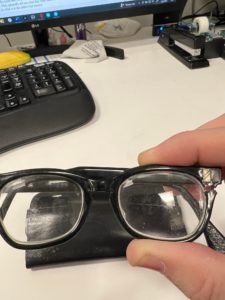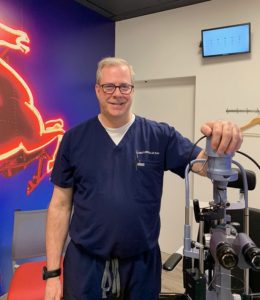January 16, 2023
By Clarke Newman, OD, FAAO, FBCLA, FSLS, FNAP
Being very myopic and having long axial lengths in both eyes, I can speak to the real-world morbidity in my own life — retinal detachments, myopic maculopathy, early cataract surgery, and glaucoma. It is easy for me to get parents on board because I am a walking, talking poster child for what will happen to their kids if they don’t act.

Dr. Newman’s first pair of glasses, which helped spark his professional myopia management journey.
My first introduction to myopia management happened in the early 1960s. When I was four years old, my eye doctor put me in a pair of flat-top bifocals to prevent myopia progression, as I was already a -2.00D -2.00D x 180 in both eyes. Ending up at -9.75D -2.00D x 180, OU, and dealing with glaucoma, myopic macular degeneration, a retinal detachment, and cataract surgery at age 52, I am very keen to prevent this misery in young children. When proper myopia management came about with the evidence base behind it, I was on board immediately.
Professional Experience with Myopia Management
I have been at Plaza Vision Center in Dallas, Texas — which was my childhood optometrist’s practice – since I graduated from optometry school in 1986. Myopia management began in my practice about five years ago as an evidence-based management system.
We were already a specialty contact lens practice, prescribing multifocals in both GP and soft lenses and orthokeratology. Then we added medical therapies (low-dose atropine) and multifocal lens strategies. So, because of that earlier experience with those lenses, the transition into myopia management was easy. As a Diplomate in the American Academy of Optometry Section on Cornea, Contact Lenses, and Refractive Technologies, I was privy to the research and the products being developed. Being friends with some of the leading scientists in childhood myopia development and management was also helpful in understanding what was being done and why.
Having the tools for specialty and medically necessary contact lenses and having had significant experience in OrthoK before implementing myopia management, I already had the tools to prescribe these lenses, which also helped make the transition easier. In terms of treatments, we offer patients both VTI’s NaturalVue Multifocal contact lenses and CooperVision’s MiSight 1 day hydrogel contact lens platforms. For OrthoK, I use both the CRT and the Euclid platforms. One piece of equipment I’ve found helpful with OrthoK is the Oculus Pentacam topographer. It images a larger area of the cornea than a Placido topographer, making designing OrthoK lenses much easier.
When it comes to creating a myopia treatment plan, each patient is unique. For the youngest patients, I try to start with low-dose atropine rather than contact lens options. But I always take into consideration the patient’s age and their level of myopia. Additionally, I have treated myopic children with combination therapies when appropriate, but I always try to stick to evidence-based research when making treatment decisions.
Patient and Parent Education
The majority of the parents who come into our practice have already researched myopia management before they walk in the door. They generally tell me what they want, and I find myself talking them down off the ledge so that we can do what is in the child’s best interest.
When communicating with patients and their parents about myopia management, I first like to frame the issue. If parents do not know what can happen to their children’s eye health later in life if this issue is not addressed, they cannot understand what you recommend. I use myself as an example. Being very myopic and having long axial lengths in both eyes, I can speak to the real-world morbidity in my own life — retinal detachments, myopic maculopathy, early cataract surgery, and glaucoma. It is easy for me to get parents on board because I am a walking, talking poster child for what will happen to their kids if they don’t act.
After these conversations, most parents are usually very enthusiastic about getting their child started in treatment. While it’s harder for the kids to envision what we’re talking about, getting through to parents has been successful.
My biggest challenge is that too many of these children are being brought in for myopia management after they are already significantly myopic. The biggest challenge is getting the word out to parents with children just starting to become myopic. We’ve adopted technologies in our practice that help get that message out to parents. The Weave phone system helps us stay connected to patients and send them regular reminders, while Doctor Multimedia and Hello Polly also manage our social media and on-hold messaging. Social media plays a significant role in getting patients’ and potential patients’ attention, and countless studies have shown how influential these platforms are. Staying on top of these channels and having a way to reach patients in this way consistently is essential.
The Future of Myopia Management
The most fulfilling part of offering myopia management is ensuring that fewer children will grow up to experience the same eye health problems with which I have suffered over the years.
When looking to the future, having novel myopia management spectacles will change the game — especially in the youngest patients. That is what I’m looking forward to the most about the future of this field. Myopia management spectacles will be a great adjunct to existing medical and contact lens therapies — and will be used in some children as a monotherapy. The future of myopia management is exciting!














